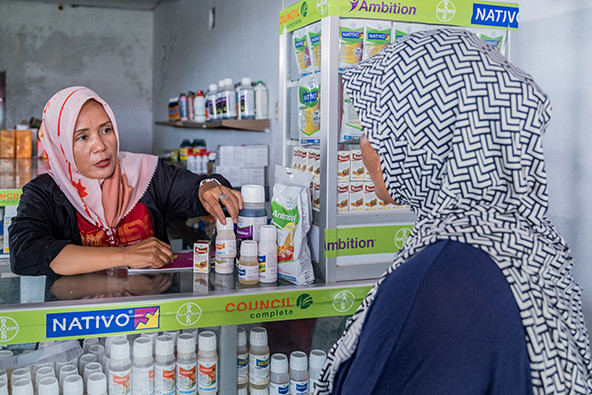 Faucik Lestari, an agri-entrepreneur and owner of the Better Life Farming Center in Central Java, Indonesia, shares guidance with a female farmer about crop protection. (Photo courtesy of Bayer)
Faucik Lestari, an agri-entrepreneur and owner of the Better Life Farming Center in Central Java, Indonesia, shares guidance with a female farmer about crop protection. (Photo courtesy of Bayer)
The kick-off article to this series shared a startling statistic: Forty percent of the world’s population is highly vulnerable to the effects of climate change, and most of the people in this group live in the countries least responsible for causing it. What’s also startling is that climate change is one of this group’s least immediate concerns. These communities lack access to health care, struggle with food insecurity and water scarcity, and generally have difficulty meeting basic needs.
While climate change is certainly one root cause of these problems, simultaneously addressing climate change and inequity, or climate justice, requires that we examine human well-being, not just environmental progress. How can people withstand the impacts of climate change or help solve the problems they face if they aren’t healthy enough to thrive day to day?

Businesses—in their myriad roles as employers, suppliers, and investors—need to lean into end-to-end sustainability by taking actions that improve not only the environment but also livelihoods, particularly among vulnerable communities in their value chains. And while all companies can evolve their approach to put equal or more weight on building healthy communities, companies that provide essentials like health care services and food supplies have a particular opportunity to develop goals and plans that take overall well-being into account, and that support the environment and society in parallel.
Whatever specific approach a business takes to achieve this, it must make environmental and societal sustainability integral to its operations, and secure the full support of leadership so that all decisions, investments, innovations, and measurement systems are meaningfully embedded into the business. Here are five ways to start.
1. Supply Chains
As with their environmental footprints, companies need to evaluate how and when they can support health and livelihoods across the full range of their business activities, and then take action across their supply and value chains. For example, any company, no matter its industry, can build an “anchor” facility in a low-income community that employs local residents and supports their well-being. Pharmaceutical maker Moderna, for instance, recently announced that it would build an mRNA vaccine manufacturing facility in Kenya. The facility will provide new jobs in the region while producing urgently needed vaccines for all of Africa. And given Moderna’s pledge to achieve net-zero carbon emissions by 2030, the company will also likely design the facility in an environmentally sustainable way.
Companies can also create goals for their environmental, social, and governance (ESG) strategies that both improve the well-being of suppliers in the near term and lay a foundation for them to minimize their environmental footprints in the future. For example, the Forever Better financing program incentivizes suppliers to work on climate and social issues. Developed by the shoe and apparel company Puma and the International Finance Corporation, the program gives the best payment terms to suppliers who make the most progress on ESG criteria like reducing carbon emissions and improving worker conditions. Meanwhile, Better Life Farming, a program developed by life sciences company, Bayer, supports smallholder farmers in low-and-middle-income countries by providing high-quality agricultural products like seeds and crop protection; educational training in farm management, market access, and entrepreneurship; and environmental consulting. The program is now starting to provide access to financing, as well as health services in countries such as Indonesia and Mexico, including guidance on self-care, nutrition, and family planning.
2. Innovation
Businesses must also design new products and services, particularly health care solutions, with the needs of a diverse set of consumers and communities in mind. With half the world’s population lacking access to basic health services, there’s an opportunity to tailor solutions to this audience who is seeking out and willing to spend money on quality products and services.
Tailoring health care for different populations and consumer needs requires that companies consider the different social determinants of health (including environmental conditions), levels of trust toward the health care system, and cultural norms. Health benefits provider United Health Group, for example, recently committed to building a more racially and ethnically diverse health workforce through improved training programs at historically Black colleges and scholarship programs. A representative workforce makes it more likely that health practitioners will understand the unique needs of different patients and innovate around their approach to care. This has proven to improve comfort levels and reduce health disparities among patients, and can lead to higher quality care.
Another example is Bayer’s Consumer Health division, which set a goal to expand access to everyday health for 100 million people in underserved communities by 2030. To be both a business and societal success, the company must rethink its design. It must create products based on the unique medical needs of underserved consumers, increase the physical availability of products, and do it at price points consumers can afford, in stores they frequent. As a part of the company’s commitment, Bayer initiated research on health issues like asthma, where a disproportionate number of people who suffer from it live in environments where air pollution is common. This research will help inform the design, pricing, and placement of new products and services that serve their needs.
Companies can also look beyond their own walls for innovative ideas. For example, beer brewer AB InBev presents 10 environmental and social sustainability challenges each year to entrepreneurs worldwide, and awards $100,000 yearly to successful candidates to support pilot projects and mentorship. In many cases, this support has ultimately led to innovative programs that improve well-being in underserved communities, including upcycling saved grains from brewing processes to produce nutritious foods and developing technologies to improve water quality.
3. Investment
Achieving environmental and societal sustainability requires meaningful investment, so it’s important that companies think of sustainability as a business-building strategy, rather than a separate pillar of work or as part of corporate social responsibility. Integrating sustainability with strategic planning means that investment decisions deliberately improve health and livelihoods, the planet, and a company’s bottom line. Sustainability shouldn’t be an afterthought; it should become part of the overall way a company futureproofs its operations.
As part of this, it’s important to develop a measurable action plan. While many companies partner with the Science Based Targets Initiative—an organization that helps them set science-based, measurable emissions reduction targets—measurement standards focused on societal sustainable goals, such as improved access to health care or nutrition, have been more elusive. Health technology company Philips, however, has been doing some interesting work in standardizing metrics as a part of its Future Health Index, a research-based platform that shows how countries around the world are shaping the future of health care. Its holistic “value measure” indicates the value health care systems deliver in different markets, including their accessibility, affordability, trustworthiness, effectiveness, and efficiency. Taken together, these measures can better reflect the full return on and impact of an investment.
To bring more precision to social sustainability goals, Bayer audits its sustainability work with the same rigor as its financial work. In addition, its board of management remuneration is tied to progress against all sustainability targets, not just the environment, and the company has an external sustainability council and supervisory board group focused on progress and governance.
4. Influencing Policy
Of course, policy also plays an integral role in building healthy, resilient communities. Businesses can bolster existing government health programs through employee policies and leverage their scale to positively influence the public sector.
Throughout the COVID-19 pandemic, for example, many companies enhanced and evolved employee benefits to supplement or gap-fill government policy. Benefits are often expanded to include access to and coverage for telehealth services, mental health services, and supplemental reproductive care. On the public sector influence side, medical technology company Becton, Dickinson, and Company partners with the President’s Emergency Plan for AIDS Relief (PEPFAR) on Infection Prevention and Control. The project improves phlebotomy practice (drawing blood) to stop HIV/AIDS transmission. Public-private partnerships like this one have helped save 21 million lives, prevented millions of HIV infections, and accelerated progress toward controlling the epidemic in more than 50 countries.
5. Community Resilience
Finally, many businesses have the scale and resources to provide aid to communities experiencing hardships due to extreme weather events or other disasters. But they can also use their scale and resources to generate—in partnership with local governments and NGOs—jobs and infrastructure that enable healthier communities longer-term. This is important, because disasters related to climate change will likely become even more prevalent, and communities can’t rebuild from scratch every time.
Initiatives that build resilience don’t necessarily require policy change or new regulation; they can simply help people with basic health needs. For instance, Bayer is working with the social enterprise reach52 as a part of its The Nutrient Gap Initiative. The partnership aims to expand access to vitamins and minerals for 50 million people in underserved communities by 2030. Together, the organizations are training community health volunteers in Kenya to become reach52 agents. Based on nutrition data the agents collect, they will supply hard-to-reach communities with nutritional education and supplements specifically targeted to their nutritional needs.
Many retailers are also bringing health services into their stores. For instance, CVS’s Health Zones initiative invests in partner-led, in-store services that help people address a range of factors that lead to health disparities, including lack of housing, access to food, or workforce training. Walmart Health Clinics meanwhile offer low-cost, convenient, quality health care services (including dental and vision care, and diagnostics) with transparent pricing for uninsured people. Both initiatives are meeting communities in need where they already shop and live, reducing the barrier to health access with practical and convenient solutions.
To conclude, business commitments to climate neutrality and net-zero carbon emissions will only take us so far along the road to climate justice. To help vulnerable communities withstand and fight the impact of climate change, solutions must include meeting their basic needs and improving overall well-being. Companies can and should be in the business of health—as employers, suppliers, and investors—and commit to examining and evolving their value chain, innovation approach, investments, community endeavors, and policy influence with healthier, more resilient communities in mind.
Support SSIR’s coverage of cross-sector solutions to global challenges.
Help us further the reach of innovative ideas. Donate today.
Read more stories by Daniella Foster.

